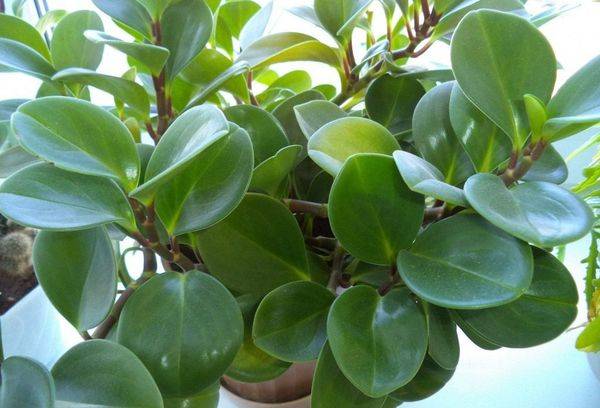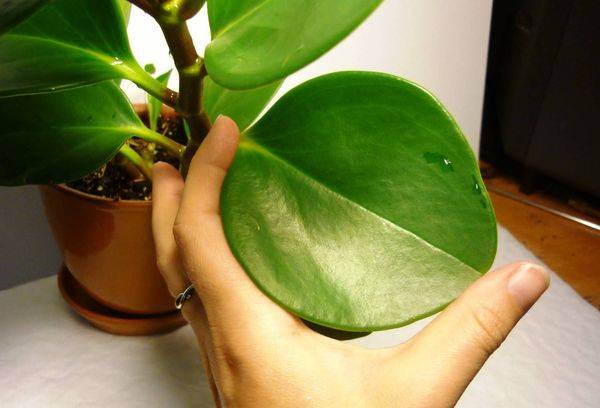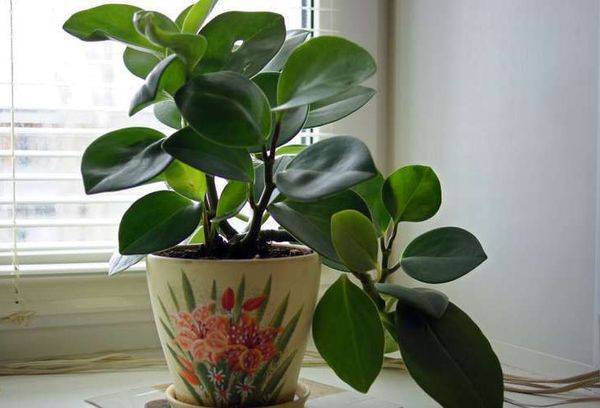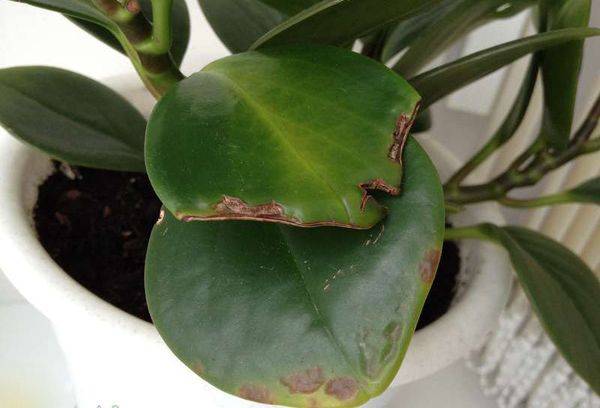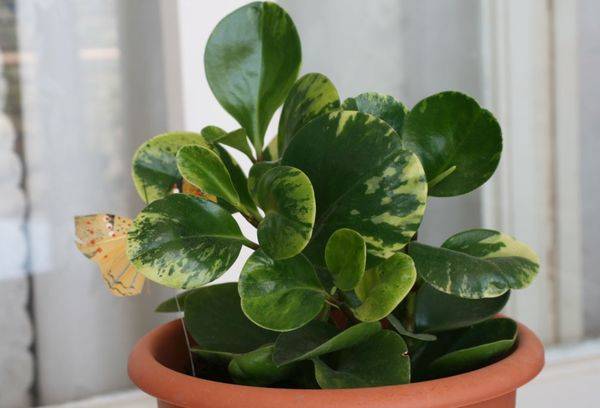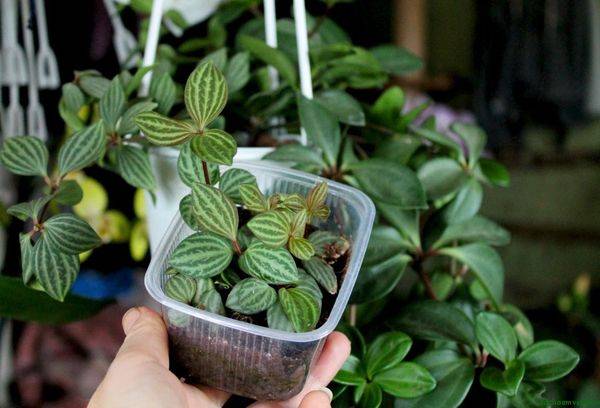Tropics on the windowsill: proper care for the dystrophy peperomia
Beautiful and well-groomed peperomely stupid will become a worthy decoration of the home collection. This flower is a good start for a beginner grower, as care for it is minimal, and it will bring a lot of joy. The peperomia of the blunt has luxurious green foliage and many strong shoots, it is not tall and slightly spreads along the ground.
The flower is viable and hardy, quickly adapts to different conditions of detention. However, there are a few nuances that will be useful to know in order to grow a strong ornamental plant.
History and Description
The genus peperomia is the most numerous of the pepper family, it has about 900 varieties. The peperomia dupolefolia species is distinguished by flower growers among the rest due to its high decorative characteristics. This is an evergreen undersized perennial with large and dense foliage. The plant came from the tropics, so it needs high-quality lighting and good watering.
Peperomia obtusifolia - external signs:
- leaves are oval and dense, sitting on the petioles and ending in an obtuse angle;
- the color of the leaf plate is dark green, sometimes a yellowish edging passes along the edge;
- the sheet is leathery and shiny, covered with a waxy coating;
- venation on foliage noticeable, arched;
- peduncle with spike-shaped inflorescence, seemingly nondescript;
- the beginning of growth is erect, then the shoots begin to branch and spread along the surface of the soil.
Tip
In the home interior, peperomia successfully looks like an ampelous or suspended plant. In the summer, these flowers are put on the windowsills and hung on the balconies.
Peperomia vulgaris is divided into varieties, the differences between which are in the shape and size of the leaves, their structure, quality and color. The hue range of foliage is the most diverse: from delicate cream to rich green. Flowering in all representatives of the species is inconspicuous, peduncles are pale in color and resemble the young stems of the plant.
Home Care
The homeland of peperomia is the tropics of Central and South America, some species are common in Brazil, Asia, India and Ecuador. In wildlife, the plant is accustomed to humidity and good diffused lighting, as it populates the lower and middle tiers. At home, peperomia belongs to the category of unpretentious indoor flowers that are easy to propagate and grow. In the store you should choose the most healthy and attractive plant - with perfect shiny leaves and thick elastic branches.
Basic rules for growing:
- Conditions of detention. The preferred temperature range is up to + 25 ° C, preferably without strong fluctuations. Peperomia prefers good illumination, and develops well in partial shade. Direct rays of light are detrimental to foliage. The plant needs a moist microclimate, it needs frequent watering and daily spraying.
- Priming. The best base for peperomy is a well-drained fertile soil with neutral acidity. The mixture is recommended to be composed of equal parts of sod and humus land, peat and coarse sand. The flower pot must have a hole.
- Watering. The soil in the pot should not dry out; to do this, provide the plant with moderate and regular moisture. Watering should be done as necessary: in summer - more often and more abundantly, in winter - less often and to a lesser extent. The main symptoms of a lack of moisture are darkening and falling of leaves.
- Fertilizer. Half-dosage liquid flower dressing should be applied during the summer once every 2-3 weeks.
- Reproduction. The most popular method of propagating peperomia is with stem or leaf cuttings. They are rooted in wet sand or a mixture of sand and peat. Compliance with heat and good moisture will allow you to achieve high-quality roots in a month. After this, the stem is transplanted into another pot as an independent plant.
- Transfer. Peperomia is resettled in the spring. This plant has a small root system, so the ideal capacity for it is wide and not deep. A quality stalk when planting should have 2-3 leaves or internodes.
- Pruning. Sanitary cutting of diseased and dry branches is necessary for all varieties of peperomia. Experienced flower growers skillfully form beautiful bushes from overgrown plant shoots. If the length of the branch exceeds 18-20 cm, it must also be cut. Heavy long branches often break off under their own weight.
- Features The color contrast and decorative qualities of the flower are lost when the roots stagnate. Peperomia requires drainage - a sufficient layer at the bottom of the pot. On hot summer days, it is useful to put the plant on a pallet filled with wet expanded clay or sphagnum.
Observance of cleanliness is an important nuance of caring for the blunt-headed peperomia. The plant will respond to frequent washing and plentiful spraying with an impeccable appearance. Especially lush and fleshy peperomia grows in the humid and warm atmosphere of the kitchen. This useful flower enriches the air in the room with oxygen, cleansing it of toxins and contaminants.
Diseases and Pests
The fleshy leaves of peperomia are a treat for many pests: weevil, aphids, spider mites, slugs and mealybugs. The natural defense against the disease is the specific perimeter odor emitted by the plant. This property is used by people for medicinal purposes. After touching the flower, during spraying, cutting or polishing the leaves, the aroma becomes more intense and brighter.
Inhalation of volatile volatile products relieves headaches and treats migraines. If the plant cannot cope with the pests on its own, wash the leaves and stems with soap and water, and then treat the flower with insecticides.
Tip
Peperomy plant is necessary in homes where there are children and people with reduced immunity. This indoor flower releases phytoncide substances with a bactericidal and disinfecting effect.
The benefits and harms of stupid peperomia are a topic of discussion and debate. Proponents of the positive effect of a flower on a person note its favorable properties. It has a powerful antimicrobial and bactericidal effect. After communicating with the plant, a person receives a boost of vital energy and feels a surge of strength. However, the flower may be harmful to allergy sufferers.
Reproduction and pruning
The translation of the name of the culture sounds like “pepper-like”. With pepper it is related in origin and spicy aroma. In wildlife, peperomia spreads along the surface of the earth and braids tree trunks. Its leaf is arranged in such a way that it contains a supply of moisture, which is necessary in tropical conditions of existence. In the natural environment, the plant reproduces by seed. It is difficult to achieve seed ripening at home, so cuttings and leaves are used for these purposes.
- the leaf for reproduction should be large and healthy, without defects and damage;
- the propagation stalk is taken from the side branches or tops; several internodes should be present on it.
The prepared leaf or stalk is placed in water to grow roots. For the best growth and development, young plants require greenhouse conditions - good illumination, elevated temperature and humidity. To do this, cover the container with glass or polyethylene. In this case, the rules of care remain the same as for an adult plant.
Tip
purityis.decorexpro.com/en/ recommends pinching the top of the plant, after which the flower releases a lot of side shoots. Peperomia becomes more magnificent and voluminous.
Pruning compact varieties of peperomia is to remove dry and damaged parts of the plant. After these events, the flower begins to grow with renewed vigor - it releases a lot of young branches and fresh leaves.
Indoor flower peperomia will delight its owner with many years of green and fragrant life. Its beautiful patterned leaves will not go unnoticed in the home flower collection. Original and unusual look composition peperomii dupolevnoy with miniature trees, bonsai and moss. And unpretentious nature and resistance to diseases will please any grower.
